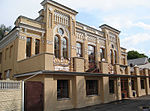Halytska Square

Halytska Square (Ukrainian: Площа Галицька, lit. 'Galicia Square', translit.: Ploshcha Halytska) in Kyiv, the capital of Ukraine, is a large square in the city. The square is in Shevchenkivskyi District and located on Kyiv's main westward thoroughfare (Prospect Beresteiskyi – bulvar Tarasa Shevchenka) being its one of the main transportation hubs. Located on the opposite side of the Old Kyiv, the square is also one of extreme points of the neighborhood along with Maidan Nezalezhnosti. It is a crossing of several historic streets such as Saksahansky street, Taras Shevchenko boulevard, Zhuliany street, Boulevard-Kudriavets street - it is a beginning of Prospect Beresteiskyi - one of the longest and broadest avenues (parkway) in the city. It gained its current name in February 2023. Prior to that it was named Victory Square (Ukrainian: Площа Перемоги, translit.: Ploshcha Peremohy), this name was dedicated to victory in World War II.
Excerpt from the Wikipedia article Halytska Square (License: CC BY-SA 3.0, Authors, Images).Halytska Square
Halytska Square, Kyiv
Geographical coordinates (GPS) Address Nearby Places Show on map
Geographical coordinates (GPS)
| Latitude | Longitude |
|---|---|
| N 50.4469 ° | E 30.4922 ° |
Address
Галицька площа
Halytska Square
01054 Kyiv
Ukraine
Open on Google Maps










